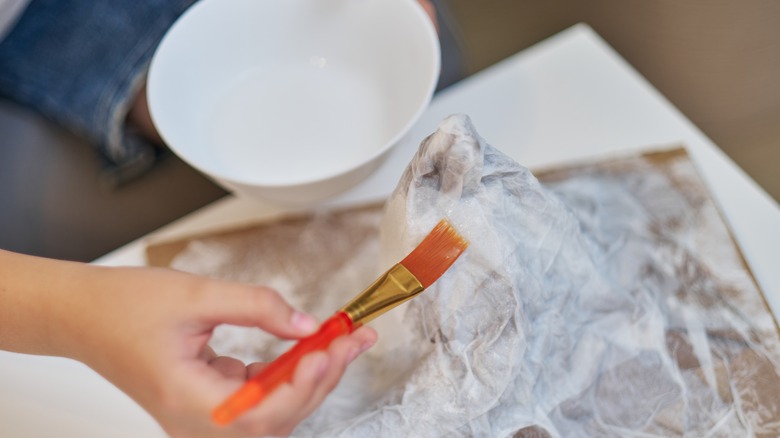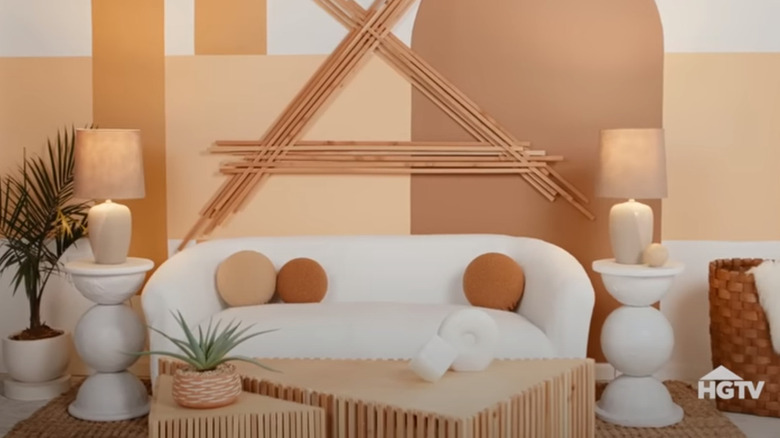Bargain Block: Keith Bynum & Evan Thomas' Guide For A DIY Plaster Style Side Table
Plaster and plaster-look furniture and accent pieces are a hot current trend in modern interiors, often augmenting a sleek and sculptural style that employs soft lines, curved and comfy furniture, and abundant textures. What better way to incorporate these pieces than in the form of accent tables? These smaller tables, according to HGTV's "Bargain Block" hosts Keith Bynum and Evan Thomas, can be a small, but defining touch in any room. Bynam and Thomas recently showed YouTube audiences a great DIY upcycling project using two thrift store globes to create a stunning faux plaster table. Covering it in paint and paper mache, they turn inexpensive supplies into a budget-friendly table that rivals much more expensive plaster tables at trendy retailers.
To create the table yourself, you will need two similarly-sized globes, a wooden dowel, and two wood rounds. Using a papier-mâché technique, you can create a textural base that when painted, looks like plaster without being overly heavy or expensive. The white-painted table is the perfect side table in rooms with a contemporary or 1970s retro-mod style.
Creating a faux plaster table
To create a faux plaster side table, Keith Bynum and Evan Thomas begin by carving one of the spheres in half with a utility knife while leaving the other whole. Drill a 1-inch hole in each of the halves, and two opposing holes in each end of the intact globe. Prepare your paper-mâché paste by mixing equal parts water and flour. They use strips of newspaper, but you can also use tissue paper or other thinner varieties of paper. Coat the strips briefly in paste before smoothing them onto the globe. Add several layers, then allow the globes to dry overnight. The next day, apply another 1-2 layers to create additional texture, allowing the paper to wrinkle and form crevices that hold the paint.
Create the base for the table using a 15-inch wood round and a 1-inch wooden dowel cut to 23 1/2 inches fastened together with a large screw in the middle of the round. Add the globes to the dowel, beginning with one half facing upward followed by the whole globe and the final one upside down. Attach another 15-inch round to the top tightly, screwing tight to create a compression that will keep everything in place.
Finish by adding more papier-mâché over the base and top to match the rest, then paint it with spray paint in your desired shade. Add a polyurethane coat over the paper to keep the tabletop looking good, protecting it from scratches or moisture.
Other ideas for this technique
Since the tables are inexpensive to create, you can make two to flank your sofa or use separately in any room as stylish side tables or budget-friendly nightstands. You can paint the finished tables a wide variety of colors, including gray or brown for a stone look, or cream or white to resemble plaster or stucco. While Keith Bynum and Evan Thomas use a simple white matte, you can also substitute a textured stone paint, which will add even more detail and texture to the globes.
While thrifted globes may not always be easy to find everywhere, you can also make this same design using any pair of spherical objects that can be arranged in a similar way. Create the full sphere in the middle by using two large half-sphere bowls or planters glued together. While this DIY creates a slender side table, you can also use the paper-covered globes for other similar creations, like a coffee table with a spherical base and a glass top. Or create smaller versions of the DIY as pedestals or plant stands simply by using smaller spheres, dowels, and wooden rounds.

